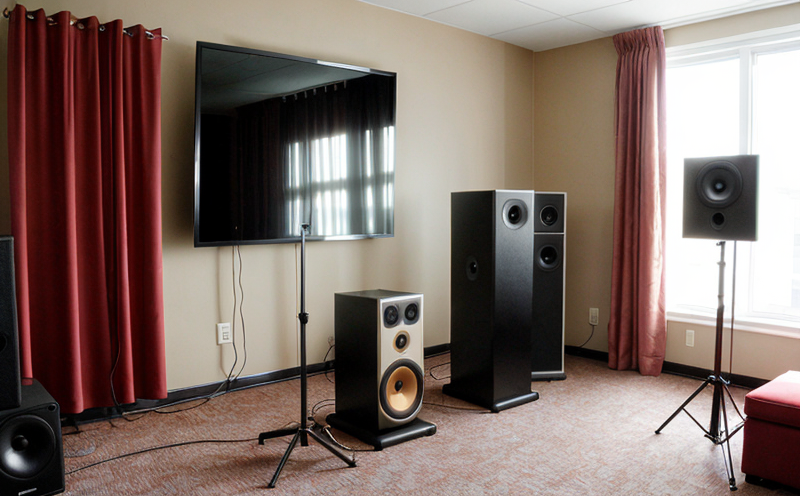Psychoacoustics & Human Perception Testing
The field of psychoacoustics is a fascinating intersection between psychology and acoustics. It deals with how people hear sounds, perceive them, and respond to them. This testing service is crucial for industries where the auditory experience plays a significant role in user satisfaction or performance.
Psychoacoustics involves understanding the psychological and physiological responses of humans to acoustic stimuli. By examining these responses, we can determine the most effective ways to design products that enhance hearing comfort and reduce noise-induced stress. This testing is particularly important for consumer electronics, automotive interiors, architectural acoustics, and industrial machinery.
One key aspect of psychoacoustic testing is determining the loudness of sounds as perceived by human listeners. This involves measuring sound pressure level and comparing it to the perceived loudness using models such as the ISO 532-1 standard. Another important metric is pitch perception, which can be assessed by altering the frequency content of a signal and observing changes in listener preference.
For quality managers and compliance officers, ensuring that products meet psychoacoustic standards helps maintain brand reputation and consumer trust. In R&D, this testing provides valuable insights into how new designs impact auditory experiences. For procurement teams, it ensures that suppliers deliver components that contribute positively to the overall acoustic performance of a product.
When conducting psychoacoustic tests, we use specialized equipment such as sound level meters, binaural microphones, and headphones. The test subjects are typically instructed on how to listen for specific characteristics in sounds, like timbre or clarity. Acceptance criteria for these tests include the ability of listeners to accurately identify target features within a specified range.
- Sound pressure levels that fall outside the ISO 532-1 standard indicate potential issues with sound comfort.
- Pitches that deviate significantly from expected values may suggest design flaws in tonal balance.
- Listener feedback is crucial for refining tests and ensuring they accurately reflect real-world auditory experiences.
The data collected during these tests are used to create comprehensive reports detailing the performance of various acoustic features. These insights help guide product improvements, ensuring that future iterations better meet user needs while adhering to international standards.
Industry Applications
Psychoacoustics & Human Perception Testing finds applications across several industries:
- Consumer Electronics: Ensuring audio quality in devices like headphones, speakers, and smartphones.
- Automotive: Improving vehicle interiors by reducing noise levels and enhancing sound clarity within the cabin.
- Architecture: Designing spaces that provide optimal acoustic environments for occupants.
- Manufacturing: Evaluating machinery sounds to minimize worker stress and discomfort.
In each of these sectors, the goal is to create products or environments where auditory experiences contribute positively to user satisfaction. By leveraging psychoacoustic testing, manufacturers can achieve this by understanding what aspects of sound are most important to consumers and then optimizing those elements in their designs.
Why Choose This Test
1. Ensures Compliance with International Standards: Our testing adheres strictly to international standards such as ISO 532-1, ensuring that your product meets global expectations for sound quality and perception.
2. Enhanced Product Quality: By identifying areas where sound can be improved, we help you refine products before they reach the market, leading to higher satisfaction among users.
3. Competitive Edge: Leading competitors are also investing in psychoacoustic testing. Stay ahead of the curve by ensuring your product offers an exceptional auditory experience.
4. Cost-Effective Early Detection: Addressing issues early in the design process saves costs and time that would otherwise be spent on post-production adjustments.
5. Expertise and Experience: Our team comprises experts who have extensive knowledge and experience in psychoacoustic testing, providing unparalleled insights into auditory phenomena.
6. Custom Solutions: We tailor our services to meet the unique needs of your industry or product line, offering flexible solutions that fit seamlessly within existing workflows.
International Acceptance and Recognition
The standards used in psychoacoustic testing are internationally recognized and widely accepted. The International Organization for Standardization (ISO) sets the benchmark through its series of documents including ISO 532-1, which provides a framework for measuring sound pressure levels related to perceived loudness.
Other relevant international bodies include:
- ASTM: Known for its standards in acoustics and noise control.
- EN Standards: European norms that align with ISO guidelines but are specifically tailored for the European market.
- IEC: International Electrotechnical Commission, which covers a wide range of electronic and electrical fields including audio quality.
Their acceptance ensures that any product subjected to psychoacoustic testing will be recognized globally, enhancing its competitiveness in international markets. Compliance with these standards also simplifies regulatory processes across different countries, reducing barriers to entry into new territories.





